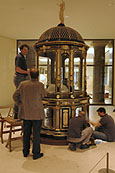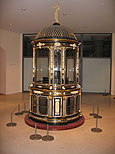The browser will either open the file, download it, or display a dialog.
The Cabinet of Alessandri and Son at the Paris Universal Exhibition of 1867 |
|||
| Until recently, the round display case or "cabinet" exhibited by Alessandri et fils (Alessandri and Son) at the Universal Exposition of 1867 was known only through reproductions in the Art Journal (fig. 1) and the Illustrierter Journal Katalog der Pariser Industrie Ausstellung (Illustrated Journal Catalog of the Paris Industrial Exhibition) which were published on the occasion of the Universal Exposition of 1867. Writing in the former, J. Beavington Atkinson called it one of the masterpieces of the Exhibition: "The CABINET of ALESSANDRI AND SON was not only a chef-d'oeuvre of the Exposition: it is one of the most perfect productions of modern times. It is of ebony, but all the enrichments are of ivory—wrought by the hand of a sculptor—an artist of the very highest order. The four FIGURES that occupy niches in the base, the smaller figures in low relief, and the several minor details, are all admirable in design and execution!"1 Recently rediscovered in the storage rooms of the Petit Palais (the piece was possibly acquired as part of the Dutuit bequest in 1902), it is now on display in the museum (figs. 2, 3). Made of darkened pear wood, ivory, and gilded bronze, it measures 365 cm in height and 170 cm in diameter. I present here some of the research I have done on Léon-Joseph-Thomas Alessandri and on the artists who collaborated with him on the execution of this exceptional Renaissance-style piece of furniture. | |||
| In the Archives Nationales in Paris is a group of letters addressed to Alessandri, in response to his request to the French state for a certificate of non-naturalization for his son Pierre Antoine so that he might escape the draft. From this document we learn that Léon-Joseph-Thomas Alessandri, "an ivory merchant in Paris," was born in Ravenna, Italy, on April 12, 1803. We don't know when Alessandri settled in France, but in 1852 he resided at 27 rue Folie Méricourt, situated between the Place de la Bastille and the Place de la République, in what is currently the 11th arrondissement of Paris. Between 1844 and 1867, Alessandri participated regularly in the Expositions des Produits de l'Industrie (Expositions of Industrial Products) and the Universal Expositions organized in Paris. In 1861, he was listed for the first time in the Annuaire-Almanach du commerce (Commercial Annual Directory); together with his oldest son, he continued to be listed until 1872. "Alessandri et fils" were classed as "tabletiers," artisans specializing in the fabrication of small objects of bone, ivory, tortoise shell, and mother of pearl. | |||
| Some time in April 1844, Alessandri applied for a patent for "a machine to peel (dérouler) ivory, invented and perfected over a period of five years." This patent, together with a descriptive memorandum and two drawings, is currently kept in the Institut National de la Propriété Industrielle (National Institute of Industrial Property). The patent was issued on August 12, 1844. At the 1844 exposition, Alessandri received an honorable mention for the presentation of his invention. The Rapport du jury describes his activity as follows: "The ivory products of M. Alessandri consist primarily of piano keys, palettes, billiard balls, souvenir plaques, and, especially, thin sheets to paint on. Through a process in which the piece of ivory turns while the saw is stationary, M. Alessandri can obtain very long sheets as wide as the entire length of the piece of ivory. He has presented at the exposition a sheet of 2 meters by 67 cm. That rolled sheet can be straightened out without cracking or even chapping."2 | |||
| In 1849, Alessandri won a silver medal at the Exposition des Produits de l'Industrie. The jury's spokesman, Léon Feuchère, gave a long description of all the applications of Alessandri's "very ingenious machine." He cited chests made by the sculptor Jean-Baptiste-Jules Klagmann that were decorated with sheets of ivory produced by means of the Alessandri process, and underscored the importance of this invention for miniatures painters.3 At the exposition of 1855, Alessandri's fine combs, piano keys, and sizeable chests, composed of single ivory sheets "that could not have been executed without his system, "earned him a first class medal.4 | |||
| The 1867 International Exposition marked the peak of Alessandri's career. He exhibited in two sections: class 14 (furniture) and class 26 (diverse objects: leatherwork, tabletterie, and basketry). Two reporters wrote in the Art Journal about Alessandri's submission. J.H. Pollen described it as the "pavilion-shaped cabinet by Alessandri" and expressed some criticism: "The proportion of ivory to ebony is perhaps too great, and the space left for curiosities or precious objects too little."5 Sydney Whiting described Alessandri's invention but attributed its origins to an Englishman by the name of State6. The most detailed description of the piece of furniture is found in the Rapport des délégations ouvrières (Report of the workers' delegations). Charles Niviller, a draftsman at the Fourdinois furniture factory, was the author of the report on the Produits de l'ameublement7 (furnishings) and he commented at length on Alessandri's piece. He provided the names of others involved in its execution: the draftsman Alexandre Eugène Prignot (b. 1822), who "has also directed the execution," and the sculptor Albert-Ernest Carrier-Belleuse (1824-1887), who made the models for the reliefs. Situated at the base of the case are four full-length female figures representing Architecture, Sculpture, Commerce, and Work. To Niviller, those figures, done by an inexperienced craftsman, lacked force. Finally, the sculptor Victor Bernard (1816-after 1892) executed the figure of Victory that stands on top of the dome. | |||
| For the production of his chef d'oeuvre, to be featured at the Universal Exposition of 1867, Alessandri, an ivory manufacturer specializing in tabletterie, surrounded himself by a group of specialists, designers as well as sculptors, who played an important part in the conception and ornamentation of this piece of furniture. This artistic collaboration did not fail to elicit some rivalry and questions regarding the authorship of the case, as we read in Auguste Luchet's L'art industriel à l'Exposition universelle de 1867: "That piece of furniture presents an interesting case: MM. Alessandri take credit for its conception, and likes everyone to know that it has been executed in their ateliers; they are right. People have boasted of lesser things. It is a kind of temple of riches, made of ebony, three meters high, with figures, reliefs, and low-reliefs made of ivory, all beautifully executed. Unfortunately, it is all touched up, loaded, even overloaded with gold but it nevertheless reminds us somewhat of the splendid dreams of our dear Eugène Sue, when, in Le Juif errant, he built the gate of Mademoiselle de Cardoville. It's an audacity à la Barbedienne, a fantasy of the kind that singers and empresses come up with. But Barbedienne, who embodies taste and esprit, would not have put gilded bronze on it. We initially had the idea of attributing part of the conception to Master Prignot, but the manufacturers denied that. Too bad for the latter, but perhaps to the good of the former."8 | |||
| It is clear that, while the Alessandris wanted all of the credit for the showcase for themselves, critics were more inclined to attribute the design for the case to one of the artists involved. And not only the critics: some of the artists too claimed more credit for the work than they felt they had received. On July 31, 1879, Victor Bernard wrote a letter to the president of the Commission Municipale des Beaux-Arts (Municipal Committee of the Fine Arts) to request financial aid. In the letter, he awkwardly expressed his disappointment with being forgotten and not having received any reward for his work: "At the Universal Exposition of 1867, I exhibited a piece in Renaissance style of which M. du Sommerard said that a work of that quality had not been produced for a long time. M. Alexandrie [sic] for whom I alone worked, obtained a large gold medal and I missed out on all rewards, even though it was known that the work was done by me alone." | |||
| In conclusion, the cabinet of Alessandri and Son is a collaborative work that combines the talents of a habile industriel (skilful industrial craftsman) with an ornamental designer and two sculptors. To demonstrate his skill in ivory cutting and veneering, Alessandri relied on the talents of several artists, whose roles and relative importance in the execution of the piece is difficult to evaluate. | |||
|
Dominique Morel, |
|||
|
1. J. Beavington Atkinson, "Furniture," The Illustrated Catalogue of the Universal Exhibition (published with the Art Journal) (London and New York: Virtue & Co. 1867), 269. 2. Rapport du jury central, Exposition des Produits de l'industrie française en 1844, vol. 3 (Paris: Fain et Thunot, 1844), 131 3. Rapport du jury central sur les produits de l'agriculture et de l'industrie exposés en 1849, vol. 3 (Paris: Imprimerie Nationale, 1850), 428. 4. Rapports du jury mixte international, Exposition Universelle de 1855, (Publié sous la direction de S.A.I. le prince Napoléon) vol. 2 (Paris: Imprimerie impériale, 1856), 533. 5. J. H. Pollen, "Report on Fancy Furniture," Reports on the Paris Universal Exhibition 1867, vol. 2 (London: Eyre and Spottiswoode, 1868), 293. 6. Sydney Whiting, "Report on Leather-work, Fancy Articles and Basket-work (class. 26)," Reports on the Paris Universal Exhibition 1867, vol. 2 (London: Eyre and Spottiswoode, 1868), 586. 7. Exposition Universelle de 1867 à Paris. Rapports des délégations ouvrières...Ouvrage comprenant 100 rapports, vol. 1 (Paris : A. Morel, n.d. [1868]), 59. 8. Auguste Luchet, L'art industriel à l'Exposition Universelle de 1867 (Paris: Librairie Internationale, 1868), 140–41. |
|||





